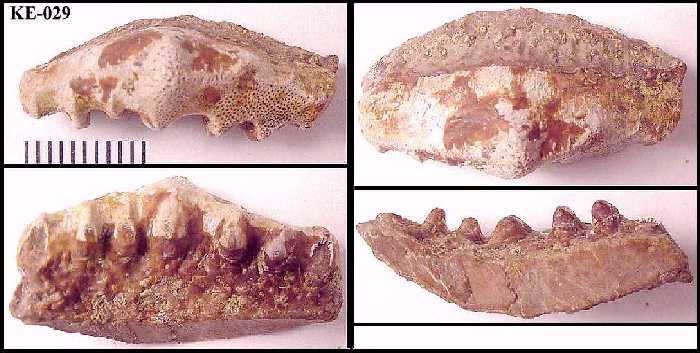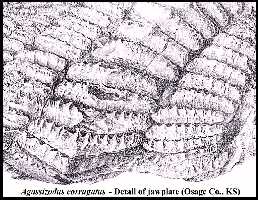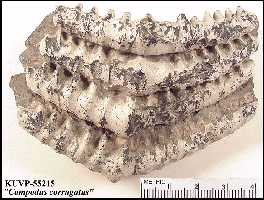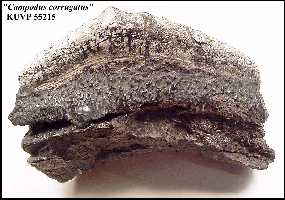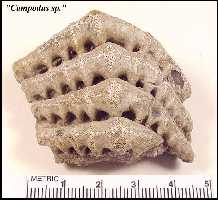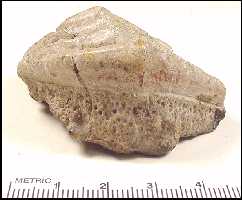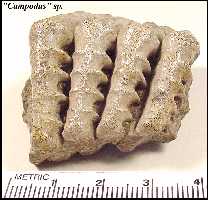SEVENTH ANNUAL MEETING.
121
___________________________________________________
RARE FORMS OF FISH IN KANSAS.
_________
BY B. F. MUDGE.
_________
About a year ago, there were sent to Ron Alfred Gray,
of Topeka, two fragments of fish jaw, without any statement. of where they were found. The
singular and unusual appearance of the teeth attracted my attention, and gave me not a
little study to fix their relation to other fossils. Being at Osage City, soon after, I
procured two similar specimens, and learned that those of Topeka were from the same
locality. The jaws were from a Cestraciont Selachian - entirely new to science. It is well
known that the shark tribe, to which these belong, have no solid bones or any solid
substance in the body, except the teeth; and consequently the latter are the only parts of
the body ever fossilized, or which now remain to give us a knowledge of their structure
and habits. As the jaws are cartilaginous, when the animal dies the ligaments holding the
teeth together decay, and they become separate, and are not found in regular position. In
the present case they are found in their natural and regular position. The jaws must have
become imbedded in a firm clay, which retained the teeth together, after the cartilage
decayed. The teeth being palatal, or pavement, covered the whole surface of the mouth,
instead of being arranged in rows at the edge of the jaws, and we now have them in their
natural arrangement. Many of the Cestracionts have no order in the position of their
teeth; but in this specimen the rows are very regular, and must have numbered five hundred
and sixty (560) in a single jaw. The largest teeth - two and a half inches in basal length
-are found in the center of the mouth, and diminish in size as they approach the front;
and the teeth also lessen in number toward the sides of the mouth. The best specimen
contained over four hundred teeth in excellent order and preservation. A portion of one
side of the jaw was gone, but the regular position of the remaining teeth was such that
the number and situation of the missing one hundred and sixty ( 160) were easily
calculated.
Knowing the value and importance of the specimen,
immediately wrote to Prof. 0. St. John, who makes a specialty of the carboniferous fishes,
in the museum of Cambridge, under Agassiz. He requested a specimen for study. He writes me
that the jaw is remarkable, in showing teeth so unlike in different rows that
paleontologists, w hen finding them separately, have described the teeth now in one as
belonging to two genera and three species. He
122
KANSAS
ACADEMY OF SCIENCE.
also adds that the lamented Agassiz [who died in 1873]stated on one occasion
that if ever a perfect jaw of these ancient, extinct Cestracionts should be discovered, it
would be found that several species now separated constitute but one. Thus ever true to
nature was this great naturalist. He finds that these Cestraciont jaws throw much light on
the earliest fossil fish, and the lowest type of fish of the present day. The affinities
in this case are so different from what was previously known, that he has considered it a
new genus and named it after Prof. Agassiz - Agazodus. [Agassizodus variabilis]
The most remarkable species of fish which we have
found, the present season, are of a genus new to me, and I think to science. They are
armed with a long, strong weapon at the extremity of the upper jaw, something like that of
a sword-fish, but round and pointed and composed of strong fibres. The jaws are provided
with three kinds of teeth. On the outer edge is a row of large, flat, cutting teeth,
somewhat resembling those of a shark. Inside, and placed irregularly, are small, blunt
teeth; while in the back portion of the palate is the third set- small, sharp and
needle-like in shape, forming a pavement. The jaws are also fibrous, like the snout. There
are three species of this genus. Prof. Marsh has them for critical scientific examination.
[See Protosphyraena page] |
